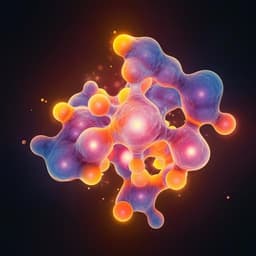
Earth Sciences
Methane formation driven by light and heat prior to the origin of life and beyond
L. Ernst, U. Barayeu, et al.
This groundbreaking research showcases how abiotic processes might have generated methane and ethane on the early Earth, driven by methylated sulfur and nitrogen compounds. Conducted by Leonard Ernst, Uladzimir Barayeu, Jonas Hädeler, Tobias P. Dick, Judith M. Klatt, Frank Keppler, and Johannes G. Rebelein, the study reveals a fascinating ROS-driven Fenton chemistry that could have played a significant role in shaping our planet's early atmosphere.
~3 min • Beginner • English
Introduction
Methane (CH4) has been crucial to Earth's climate, potentially resolving the faint young sun paradox by providing greenhouse warming during the Hadean and Archean. However, the sources and levels of prebiotic methane remain debated. Proposed abiotic sources (e.g., serpentinization) are spatially restricted, and isotopic evidence is indirect. The authors previously identified a non-enzymatic pathway for CH4 formation within diverse organisms driven by reactive oxygen species (ROS), ferrous iron (Fe2+), and methylated sulfur- and nitrogen-bearing compounds. Here, they hypothesize that the same ROS–Fe-driven radical chemistry operates outside of living cells under early Earth conditions, where heat and light generate ROS and Fe redox cycling, enabling oxidative demethylation of methylated S/N compounds to produce CH4 and C2H6 across widespread aqueous environments. The goal is to test whether light- and heat-driven Fenton chemistry could have produced significant abiotic methane prior to life and been further amplified after life emerged.
Literature Review
Background studies indicate that early Earth required elevated atmospheric CH4 and potentially C2H6 to maintain a warm climate under a fainter sun. Abiotic CH4 release from submarine volcanism and as a byproduct of serpentinization has been proposed, but the relative contributions are uncertain. Geochemical constraints based on mass-independent sulfur fractionation suggest ≥20 ppmv CH4 around 2.4 Ga, and xenon isotope fractionation indicates >5000 ppmv around 3.5 Ga. After the evolution of microbial methanogenesis (≥3.5 Ga), biogenic CH4 likely dominated, although direct records are sparse. Prebiotic sources of methylated S/N compounds (e.g., methanethiol, DMS, DMSO) include synthesis in hydrothermal systems and delivery via carbonaceous meteorites. Archean oceans were ferruginous (Fe2+-rich), though Fe3+ was also present in some niches; Fe(III)-carboxylate complexes undergo photoreduction via ligand-to-metal charge transfer (LMCT). ROS exist at low levels in water and increase with heat, photolysis, or radiolysis; under acidic conditions, [Fe(H2O)6]3+ photolysis produces Fe2+ and ROS. Prior work showed non-enzymatic, ROS-driven CH4 formation across many organisms, implicating oxidative demethylation to methyl radicals. These lines of evidence motivate exploring light- and heat-driven Fenton chemistry as a widespread abiotic CH4 source.
Methodology
The study employed aqueous model systems to test abiotic CH4 and C2H6 formation from methylated S/N substrates under controlled atmospheres, temperatures, pH, light regimes, iron speciation, and presence of (bio)molecular chelators. General conditions: 4 mL reactions in closed 20 mL glass vials at 30 °C under N2 unless stated, analyzed by GC. Heat assays: 20 mM potassium phosphate buffer (pH 7), 500 mM DMSO (substrate), 10 mM FeSO4 (Fe2+) under N2. The headspace was evacuated and refilled with N2 to ensure anoxia. Samples were incubated at 37, 57, 77, and 97 °C in the dark for 6 h. Optional additions included 20 mM citrate, malate, ATP, serine, glucose, or pyruvate; Ca2+ (as CaCl2) was added for competition experiments. Light assays: 20 mM potassium phosphate buffer (pH 7), 500 mM DMSO, 2 mM FeCl3 (Fe3+) or 2 mM FeSO4 (Fe2+), ±10 mM citrate. Anoxia was created by repeated evacuations and N2 backfills. For acidic photolysis of Fe-aqua complexes, 20 mM Tris HCl buffer at pH 3 with 500 mM DMSO and either 2 mM FeCl3, 2 mM FeSO4, or a 1 mM FeCl3 + 1 mM FeSO4 mixture was used. Illumination conditions included broad-spectrum light (approximately 350–1010 nm; 82 ± 4 µmol photons m−2 s−1; 52 ± 2 kJ m−2 h−1) and monochromatic LEDs (λmax = 388, 436, 500, 534, 675, or 868 nm) with specified photon fluxes/energies; dark controls were included. Transition metal assays: 2 mM of Ce, Mn, Co, Ni, Cu, or Fe with 10 mM ascorbate (metal reductant) and 500 mM DMSO in 20 mM buffer, illuminated for 1 day. Wavelength dependence used 5 mM FeCl3, 10 mM citrate, 500 mM DMSO for 1 day illumination. Substrate screening under light used 500 mM of dimethyl sulfide, methionine, 2-methylthioethanol, trimethylamine N-oxide, or DMSO with 10 mM FeCl3 and 100 mM citrate, incubated 3 days. Analytical methods: CH4, C2H6, CO2, and H2 via GC-FID/TCD with headspace sampling; CH3OH by GC-FID on a ZB-WAXplus column. Fe2+ quantified by the ferrozine colorimetric assay. H2O2 dynamics measured continuously with microsensors under anoxic illumination and by endpoint fluorescence (Amplex UltraRed/APEX2) in strictly anoxic handling. Stable isotope measurements: δ13C of CH4 by GC–combustion–IRMS with cryogenic preconcentration; δ2H by GC–temperature conversion–IRMS, calibrated with reference standards and reported vs VPDB (δ13C) or VSMOW (δ2H). Organic radical involvement was probed using AAPH (2,2′-azobis(2-amidinopropane) dihydrochloride) at 40 °C in an anoxic DMSO-containing system. Biomass assays: Bacillus subtilis grown in LB with 10% D2O or H2O, harvested, washed, and killed by sonication/freezing to yield dead biomass; 20 mM FeCl3 and 50 mM ascorbic acid were added, samples illuminated under N2, and headspace CH4 and δ13C measured. Biological relevance: Methylocystis hirsuta cultures received CH4 produced by the light-driven model system; Methanothermobacter marburgensis served as a methanogenic control for isotopic comparisons.
Key Findings
• Abiotic CH4 forms from DMSO in anoxic, pH 7 buffer with Fe2+, increasing with temperature: rates rose from ~0.02 µM h−1 at 30 °C to ~0.82 µM h−1 at 97 °C (≈41-fold). Low amounts of C2H6 were also produced; at 37 °C, CH4:C2H6 ~110 with an increasing trend at higher temperatures.
• Light enhances CH4 formation at 30 °C: broad-spectrum illumination increased rates ≈4-fold from ~0.02 to ~0.08 µM h−1, via photolysis of water and H2O2 generation. Oxygen suppressed CH4 formation at neutral pH with Fe2+.
• Under acidic pH 3 conditions, illumination of Fe(III)-aqua complexes generated Fe2+ and ROS; Fe3+ supplementation increased CH4 formation ≈5-fold versus Fe2+. A mixture of 1 mM Fe3+ + 1 mM Fe2+ yielded CH4 rates of ~0.33 µM h−1.
• (Bio)molecules with putative prebiotic origin (pyruvate, glucose, serine, ATP, malate, citrate) enhanced heat-driven CH4 (97 °C) formation; citrate increased rates >11-fold. Corresponding C2H6 increases yielded CH4:C2H6 ratios from ~190 (glucose) to ~1100 (citrate). Adding Ca2+ competitively reduced CH4 rates (e.g., 10 mM Ca2+: ~6.32→~4.86 µM h−1; 500 mM Ca2+: ~6.32→~1.29 µM h−1), suppressing ~90% of citrate’s Fenton-promoting effect.
• Light-driven Fe redox cycling: In pure buffer under light, H2 formed at ~1.3 nM h−1 and H2O2 accumulated; Fe3+-carboxylate LMCT reduced Fe3+ to Fe2+ and produced organic radicals, sustaining CH4 formation. Citrate increased both CH4 rates and Fe2+ concentrations (e.g., ~0 to ~1.5 mM Fe2+ in illuminated, anoxic samples).
• Oxygen effects: In citrate-supplemented, illuminated systems, Fe2+ concentration dropped sharply even at 0.2% O2 and by ~96% at 2% O2; CH4 rates decreased roughly linearly with O2. Methanol was detected in oxic assays (from ~0.003 µM h−1 at 0.2% O2 to ~0.07 µM h−1 at 21% O2), consistent with CH3 radical reaction with O2.
• Iron concentration and light limitation: At low Fe3+ concentrations, CH4 rates increased faster than measurable Fe2+; at high Fe3+, CH4 rates plateaued while Fe2+ continued to rise, indicating that Fe2+ limits at low iron but light-driven ROS production limits at high iron.
• Other metals: Copper, cobalt, and cerium enhanced light-driven CH4 formation with ascorbate and DMSO, but activities were lower than iron; nickel and manganese showed no significant increase.
• Wavelength dependence: Shorter wavelengths (near-UV) increased CH4 formation and Fe2+ levels. CH4 rates rose from ~0.3 µM h−1 at 534 nm to ~1.23 µM h−1 at 388 nm; Fe2+ increased from ~1.3 to ~4.2 mM. Despite higher energy flux, broad-spectrum light yielded ~0.7 µM h−1, underscoring the importance of UV components (not shielded on early Earth).
• Organic radical pathway: AAPH-generated carbon-centered radicals with DMSO produced CH4, supporting an organic radical-mediated route in parallel with Fenton chemistry.
• Substrate scope: Under illumination with citrate and Fe, CH4 formed from dimethyl sulfide, methionine, 2-methylthioethanol, trimethylamine N-oxide, and DMSO.
• Synergy of light and heat: With Fe2+, CH4 rates increased from ~0.056 µM h−1 (4 °C, dark) to ~0.19 µM h−1 (4 °C, light) and ~0.65 µM h−1 (30 °C, light). With Fe3+, dark rates were <0.03 µM h−1, but light-driven rates exceeded those with Fe2+, consistent with LMCT and radical contributions.
• Biomass as source and chelator: Dead Bacillus subtilis biomass produced ~40 fmol CH4 h−1 mg−1 (dry weight) under light with Fe3+ and ascorbate. D2O-labeled biomass yielded strongly deuterium-enriched CH4 (δ2H ≈ −5900‰) versus unlabeled (δ2H ≈ −225‰), indicating direct conversion of biomass.
• Isotopic and biological relevance: Abiotic heat- or light-generated CH4 had δ13C ≈ −54 ± 1.1‰, less negative than methanogenic CH4 from Methanothermobacter marburgensis (≈ −59.2 ± 2.3‰), suggesting lower isotopic fractionation for ROS-driven abiotic CH4. Methanotrophic Methylocystis hirsuta grew on CH4 generated by the model system.
Discussion
The findings demonstrate that light- and heat-driven ROS formation, coupled to iron-mediated Fenton chemistry and LMCT-based iron redox cycling, produces CH4 and C2H6 from methylated S/N compounds under conditions that likely prevailed broadly on early Earth. Unlike spatially restricted mechanisms such as serpentinization, this chemistry can operate delocalized across oceans, lakes, rivers, and ponds, at ambient pressures, driven by heat throughout the water column and by light in surface layers. The presence of prebiotic methylated substrates and carboxylated ligands supports operation prior to life; after life emerged, the availability of biomolecules (as substrates and Fe-chelators) would have markedly amplified abiotic CH4 production, especially in anoxic Archean settings. The observed CH4:C2H6 ratios and the less negative δ13C signatures provide potential markers to distinguish abiotic ROS-driven methane from enzymatic methanogenesis. The data also suggest that, with sufficient LMCT-driven Fe cycling and ROS generation, abiotic CH4 production could occur even under suboxic to oxic conditions, implying contributions to modern light-correlated CH4 emissions in surface waters. These insights have implications for early atmospheric warming, potentially helping to resolve the faint young sun paradox, and for the evolution of metabolism, as early abiotic CH4 could have supported methanotrophy prior to the rise of methanogenesis.
Conclusion
This study establishes a robust, non-enzymatic pathway for methane and ethane formation based on ROS-driven Fenton chemistry, sustained and enhanced by light- and heat-generated ROS and LMCT-mediated iron redox cycling, acting on methylated sulfur- and nitrogen-containing compounds. The mechanism likely operated widely on early Earth and intensified with the rise of life due to increased availability of substrates and chelators, potentially shaping atmospheric composition and climate. Distinct CH4:C2H6 ratios and isotopic signatures offer tools to differentiate abiotic from biotic methane on Earth and other worlds. Future work should quantify isotopic fractionation mechanisms for ROS-driven CH4, constrain environmental rate parameters (e.g., light spectra, iron speciation, ligand availability), integrate these fluxes into atmospheric models of early Earth and exoplanets, and evaluate present-day contributions in diverse aquatic habitats.
Limitations
The isotopic fractionation of abiotic, ROS-driven CH4 is not yet fully characterized and requires further study. Oxygen availability strongly suppresses detectable Fe2+ and CH4 formation unless sustained iron redox cycling occurs, potentially limiting abiotic production under oxic conditions. Some measurements (e.g., continuous H2O2 production) were constrained by experimental design (open exchange with headspace), precluding precise rate calculations. Experiments were conducted in simplified model systems with high substrate and iron concentrations, and extrapolation to natural environments requires careful parameterization (e.g., realistic ligand, metal, and light regimes).
Related Publications
Explore these studies to deepen your understanding of the subject.







